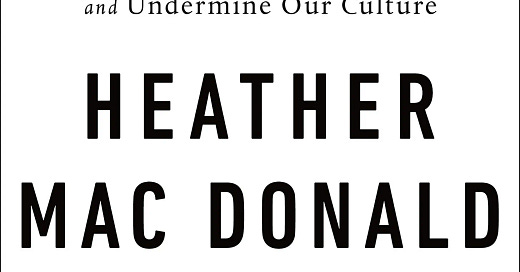Heather Mac Donald takes DEI to the woodshed
The provocative author is unafraid to write what myriad others are thinking and saying behind closed doors.
The Diversity Delusion: How Race and Gender Pandering Corrupt the University and Undermine Our Culture, by Heather Mac Donald
Grade: 95
Initial thoughts: While the book is not a comforting read, most of you will nod along, realizing the truth of Mac Donald’s words.
I’ve been a fan of Heather Mac Donald’s writing since I first discovered it in the 1990s in City Journal. She does not suffer fools, and she speaks well-researched, well-reasoned facts. Her latest book, The Diversity Delusion, makes a strong argument against the diversity obsession prevalent across the country in the public and private sectors.
Never one to shy away from a fight, Mac Donald delivers a shiv to the spleen of the arguments used to divide the nation along racial and gender lines, writing that, while such initiatives were originally intended to help minorities overcome the legacy of discrimination, they have now morphed into a de facto “affirmative action" that favors minorities over Whites and Asians.
Given what’s taking place at colleges, government agencies, and public corporations across the country, it’s hard to dismiss Mac Donald’s words, especially when she cites studies showing that minorities admitted to college or hired for jobs under the auspices of diversity, equity & inclusion (DEI) programs are often less qualified and, worse still, less likely to succeed than those who are admitted or hired on merit.
She makes a number of points in similar veins, all of which make clear her perspective that the focus on diversity undermines our shared values and leads to a decline in the importance of merit, hard work, and individual responsibility.
A nitpick
On the topic of implicit bias, however, Donald makes a point that I think deserves challenging. Discussing the high rates of violence among blacks, she makes the case that, given this reality, its only natural that there is an association between Blacks and crime. This point echoes sentiments shared by Dinesh D’Souza in his 1995 book The End of Racism: Principles for a Multiracial Society, which argued that it was natural for non-minorities to be fearful of Blacks given the latter’s high rates of violent crime. He called the people engaging in such calculus, “prudent statisticians.”
Mac Donald, however, shares a thought exercise:
“If American blacks acted en masse like Asian Americans for ten years in all things relevant to economic success — if they had similar rates of school attendance, paying attention in class, doing homework and studying for exams, staying away from crime, persisting in a job, and avoiding out-of-wedlock childbearing — and we still saw racial differences in income, professional status, and incarceration rates, then it would be well justified to seek an explanation in unconscious prejudice. But as long as the behavioral disparities remain so great, the minute distinctions of the IAT are a sideshow.”
On this point, Robert VerBruggen, an editor for the National Review, took Mac Donald to task in fantastic fashion.
“If we expect black Americans to overcome what Mac Donald describes as the United States’ “appalling history of racism and brutal subjugation,” certainly we must also insist that whites overcome their negative racial attitudes and treat blacks and whites equally even when statistical gaps may make it rational to do otherwise, so that blacks experience fair treatment during this process and are rewarded for their efforts in the job market. While cultural and behavioral issues may well play a bigger role in ongoing racial disparities than do modern-day discrimination and prejudice, the latter are non-negligible problems that warrant our attention, too.”
Final thoughts
I largely agree with Mac Donald’s assessment and analysis throughout the book. The desire to make the country’s institutions less discriminatory and more fair for minorities cannot result in more discrimination and less fairness for non-minorities.




